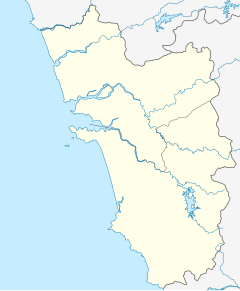Shree Betal temple
This article does not cite any sources. (August 2012) |
| Purvas Vetala (Betal) | |
|---|---|
बेताळ | |
 Betal Idol (Goa) | |
| Religion | |
| Affiliation | Hinduism |
| Deity | |
| Location | |
| Location | North Goa |
| State | Goa |
| Country | India |
 Location in Goa | |
| Geographic coordinates | 15°32′00″N 73°59′00″E / 15.53333°N 73.98333°ECoordinates: 15°32′00″N 73°59′00″E / 15.53333°N 73.98333°E |
| Architecture | |
| Completed | 1905 |
| Shree Betal | |
|---|---|
| Affiliation | Lord Shiva |
| Mantra | Om Namo Purvas Vetalaya |
| Weapon | Sword & Shield |
| Part of a series on |
| Hinduism |
|---|
 |
|
|
Shri Betal temple (बेताळ) is a Hindu temple in Amona village in the Bicholim Taluka of Goa. The presiding deity is who is worshiped as a form of Shiva in the form of a warrior; normally the idol of Shree Betal is standing in the temple, but during festivals his idol is displayed on a horse back in the village. He is the Gram devata (village lord) of Amona.
There is a temple of Shri Betal in a village named as "Gorli" in Pauri Gharwal district of Uttrakhand. Betal is also the village's gramadevata (village deity). This temple also has a Shiva Pindi and its gana.
The temple's construction prior to 1950 was funded by the Late Shri. Vithal Jagannath Telang and his name has been carved on the flooring accordingly. There is a water well 50 metres away from main temple.
Deity[]
The temple is dedicated to Purvas Vetal, the warrior god. The deity is also called 'Betal' colloquially.
Betal[]
Betal as we know him today is a deity of the indigenous Hindu people of India. Betal the god of the roaring storm, is usually portrayed in accordance with the element he represents as a fierce, destructive deity. Many stories and folklore about the valor and wisdom of 'Shri Vetala' are passed down through generations of local people who worshiped this deity. Traditionally, Shri Vetala is considered a patron deity of the Harijan people. A god named Rudra is mentioned in the Rig Veda. The name Rudra is still used as a name for Shiva. In RV 2.33, he is described as the "Father of the Rudras", a group of storm gods. Furthermore, the Rudram, one of the most sacred hymns of Hinduism found both in the Rig and the Yajur Vedas and addressed to Rudra, invokes him as Shiva in several instances.
Shaivism[]
Shaivism (Sanskrit: शैव पंथ, śaiva paṁtha) is the oldest of the four major sects of Hinduism, the others being Vaishnavism, Shaktism and Smartism. Followers of Shaivism, called "Shaivas", and also "Saivas" or "Saivites", revere Shiva as the Supreme Being. Shaivas believe that Shiva is All and in all, the creator, preserver, destroyer, revealer and concealer of all that is. Shaivism is widespread throughout India, Nepal, and Sri Lanka, mostly. Areas notable for the practice of Shaivism include parts of Southeast Asia, especially Malaysia, Singapore, and Indonesia.
History[]
The original temple was located in Amona at the same place, but later reconstructed from time to time through jeernoddhara (continual maintenance).
Devotees[]
The deity is believed to be patron deity of 96 Kulee Maratha, Kalavants, Goud Saraswat Brahmin , Rajapur Saraswat Brahmins and Daivadnya Brahmin community spread all over India. Familiar surnames of the devotees are Sinari, Gawas, Fadate, Salgaonkar, Dhond, Shet, Palankar, Parab etc.
See also[]
- Temples of Goa
- Mangeshi Village
- Shantadurga Kalangutkarin Temple
External links[]
| Wikimedia Commons has media related to Shree Betal temple. |
- Shakti temples
- Hindu temples in North Goa district
